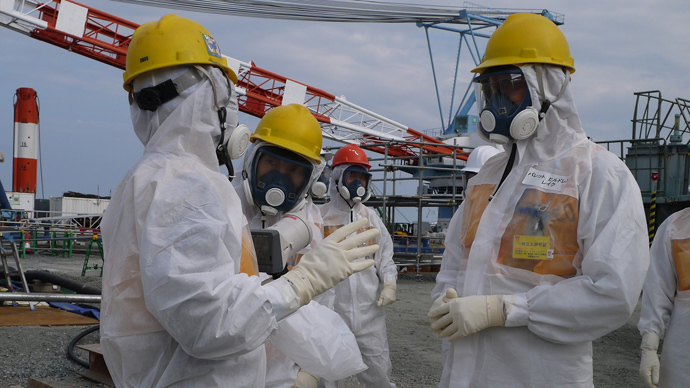Heavy rains overflow barriers surrounding Fukushima water tanks

Water has overflowed at Japan’s Fukushima Daiichi nuclear plant. Tokyo Electric Power Company (TEPCO) is attempting to discern the quality of the water and possible radioactive substances which could have been spilled.
TEPCO announced on Monday that the water overflowed in 12 areas of the plant.
Heavy rains caused water to flow over the barriers of an
artificial embankment which surrounds a dozen tanks of
radioactive water at the plant. TEPCO reported that liquid
containing a source of beta radiation was found beyond the
levees.
The company said the incident was “due to heavy rain in the
Tohoku region.” Company specialists are attempting to
identify the amount of leaked water and the radiation levels
present in the liquid.
Radioactivity levels in a well near a storage tank at the
Fukushima nuclear power plant have risen immensely, the plant’s
operator earlier reported, fueling ongoing concern about the
impact of radiation on the surrounding environment.
Last Wednesday, heavy rains brought with Typhoon Wipha caused
reservoirs for collecting rainwater to overflow. The natural
disaster was described by weather forecasters as the strongest in
a decade, leaving at least 17 people dead and 50 others missing
in its wake.
Workers at the Fukushima plant had to pump rainwater out of
protective containers surrounding approximately 1,000 tanks
holding radioactive water. It is thought that the heavy rains
lifted contaminated soil.
Shortly afterwards, radiation levels were found to have
skyrocketed. TEPCO officials said Friday that they detected
400,000 becquerels per liter of beta ray-emitting radioactive
substances - including strontium - at the site of a well near a
storage tank. The level was 6,500 times higher than readings
taken Wednesday, according to NHK World.
The news showed that radioactive substances like strontium have
reached the groundwater, according to the officials. In August,
the same storage tank leaked over 300 tons of contaminated water.
Earlier this month, TEPCO announced that 430 liters of polluted
water had spilled from a tank as the company’s employees tried to
remove rainwater dumped at the plant by recent typhoons. The
contaminated water may well have flowed into the sea, TEPCO said.
However, estimates still may be unreliable. The UN Scientific
Committee on the Effects of Atomic Radiation (UNSCEAR) raised
doubts at the beginning of the month. A preliminary report
published in the Japanese press concluded that estimates of
radioactive substances discharged at the plant provided by the
Japanese authorities, TEPCO, and other entities may have
underestimated the impact of the disaster.
The power plant was disrupted in March 2011 by a massive
earthquake and tsunami which wreaked havoc at Fukushima and
sparked a nuclear crisis in which meltdowns occurred in three
reactors. It was considered to be the world’s worst nuclear
accident since the Chernobyl disaster in 1986.
In September, a senior utility expert at Fukushima, Kazuhiko
Yamashita, said that the plant was “not under control.”
TEPCO downplayed his comments, saying that he had only been
talking about the plant’s waste water problem – not the facility
as a whole.













